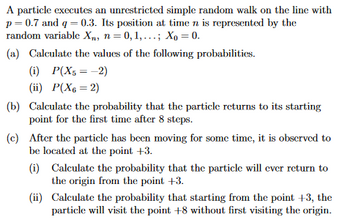
A First Course in Probability (10th Edition)
10th Edition
ISBN: 9780134753119
Author: Sheldon Ross
Publisher: PEARSON
expand_more
expand_more
format_list_bulleted
Question

Transcribed Image Text:A particle executes an unrestricted simple random walk on the line with
p=0.7 and q=0.3. Its position at time n is represented by the
random variable Xn, n = 0, 1,...; Xo = 0.
(a) Calculate the values of the following probabilities.
(i) P(X5 = -2)
(ii) P(X6 = 2)
(b) Calculate the probability that the particle returns to its starting
point for the first time after 8 steps.
(c) After the particle has been moving for some time, it is observed to
be located at the point +3.
(i) Calculate the probability that the particle will ever return to
the origin from the point +3.
(ii)
Calculate the probability that starting from the point +3, the
particle will visit the point +8 without first visiting the origin.
Expert Solution
This question has been solved!
Explore an expertly crafted, step-by-step solution for a thorough understanding of key concepts.
Step by stepSolved in 4 steps with 21 images

Knowledge Booster
Similar questions
- I need the answer as soon as possiblearrow_forwardSuppose that in a certain metropolitan area, 90% of all households have cable TV. Let x denote the number among four randomly selected households that have cable TV. Then x is a binomial random variable with n = 4 and p = 0.90. (Round your answers to four decimal places.) (a) Calculate p(3) = P(x = 3). (b) Calculate p(4),the probability that all four selected households have cable TV. (c) Calculate P(x ≤ 3).arrow_forwardLet Y be a binomial random variable with n = 10 and p = 0.3. (a) P(3 < Y < 5) = P(3 ≤ Y < 5) = (b) P(3 < Y ≤ 5) = P(3 ≤ Y ≤ 5) =arrow_forward
arrow_back_ios
arrow_forward_ios
Recommended textbooks for you
 A First Course in Probability (10th Edition)ProbabilityISBN:9780134753119Author:Sheldon RossPublisher:PEARSON
A First Course in Probability (10th Edition)ProbabilityISBN:9780134753119Author:Sheldon RossPublisher:PEARSON

A First Course in Probability (10th Edition)
Probability
ISBN:9780134753119
Author:Sheldon Ross
Publisher:PEARSON
